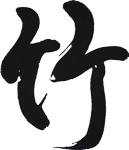The
Systemisation of the Musical Language of the
Fukezen Shakuhachi Honkyoku
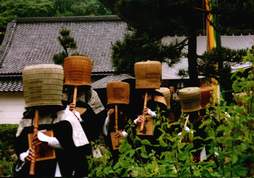
Contents
- 6. Tectonic Structure in the Honkyoku
1. Suizen - 'Blowing Zen'
Until the middle of the 19th century the shakuhachi bamboo flute, nowadays something of a symbol of the Japanese musical tradition, functioned not as a musical instrument (gakki) but primarily as a religious tool (hˇki) exclusive to the Zen Buddhist Fuke sect.
Whilst the sect's komusˇ - or “monks of nothingness” - spent most of their time playing, they did not regard themselves as musicians, for the musical activity which they engaged in, and which the uninitiated observer would surely term “playing the flute”, was actually just a form of Zen meditation in which esoterically transmitted pieces of music now referred to collectively as honkyoku (lit. “basic pieces”), were performed on the instrument.
This manner of playing the shakuhachi (known as the fuke style), as has come down to us primarily through the traditions of the Myˇanji ('Light and Darkness') Temple in Kyoto, is first and foremost a manifestation of the Zen, of its emphasis on the real and true, its focus on the essence, its rejection of that which is external and superficial. Its ideal in sound is 'the murmuring of the wind through the bamboo grove', and its basic principal is that of ichi on jobutsu, or one-sound Buddhahood. Kurosawa Kinko I (1710-1771), the founder of the Kinko Ry˙ is said to have verbalised the concept of suizen with such laconic kˇan-like pronouncements./1/ ("The members of the Fuke sect have left us with very little written material elucidating the philosophy which underlay their playing shakuhachi as suizen, the blowing Zen, the honkyoku presumably speaking for themselves". Lee 1992:132)
Within the walls of the Fuke temples the 'monks of nothingness' observed an everyday routine of discipline similar to that in other Buddhist sects, although there was great emphasis on shakuhachi-playing as a means of practising 'blowing meditation'.
Following matins with the accompanying play of prescribed compositions and zazen, seated meditation, time was set aside for shakuhachi practice, errands for alms and for perfecting martial arts. Each komusˇ could, at any time, become a samurai once again, and in fact the massive flute with its broadened base could also serve as a very formidable weapon, should such occasion arise.2. The Fuke Style and its Characteristics
The fuke style, in
contrast to other schools, strictly emphasises the original, above all,
spiritual purpose of shakuhachi playing. Every piece is essentially a
coded breathing and concentration exercise, in actual fact suizen -
blowing meditation.
It was not to be watered down with
(emotionally affected) musical effects, showy virtuosity, as, for example, in
the case of the Tozan
School.
Players of the
Myˇan tradition very rarely perform honkyoku pieces in public (in a
musical context) or at concerts, even today.
- N.B.: The Sadame document, probably dating from the end of the 17th century states in paragraph no. 19: "... During his takuhatsu (religious mendicancy) practice he (the komusˇ) should never play secular music or popular tunes. He is not allowed to participate in any artistic activities." (Takahashi - LEE, 1992, pp.117-121)
The compositions (there is nearly no improvisation in Japanese traditional music!) – always composed and respectful and faithful to fixed traditions - are known as honkyoku (original, basic pieces)/3/ koten honkyoku (ancient, time-honoured pieces), as well as fuke honkyoku, and sometimes even fukezen honkyoku (from the Fuke sects, Myˇan honkyoku from the Myˇanji Temple in Kyoto etc.), to differentiate them from the compositions of other schools of shakuhachi playing, who, of course, refer to their basic pieces as honkyoku also. Significant is the case of the Tozan school (founded by Nakao Tozan at the end of the 19th century), which resolutely excluded all spirituality from its repertoire.
Once more I have to emphasise the verbalised and deeply truthful characteristic of the style as being ichi on jobutsu, or one-sound Buddhahood. (Kurosawa Kinko I.) Fuke style really recalls most of all 'the murmuring of the wind blowing through the bamboo grove'./4/
Although honkyoku pieces are essentially coded breath exercises and instructions for meditation, all such compositions are in addition, nevertheless, exceedingly beautiful and sophisticated music! They represent unique musical phenomena and a specific and ultimate musical language, which can be investigated by means of musical theory, as any other kind of music.
Some musical aspects are determined and given by the ascetic, exclusively solo playing of the wind instrument (in the case of participation at a religious ritual, all the players try to perform in unison!), thus eliminating the possibility of using chords, harmony, polyphony etc.
Other limitations are the dominant role of spirituality in the pieces (the principle of suidan - phrase of one full breath) which eliminates time-measured pulses and rhythmisation, where the use of easily remembered lyrical melodies is unsuitable, and so on.
The musical projection of these
pieces, despite such constraints, is demonstrated on the level of musical
thought, notably tectonics, which are interesting, highly organised
structures with surprisingly subtle and complex internal relationships. They
cannot be chance or even improvised. For that matter, improvisation is
practically non-existent in traditional Japanese music!
3. Koten Honkyoku
There are about 150 compositions preserved. Most of them are actually variations and derivatives of some tens of compositions, which, through the long period of oral transmission in various localities, have, in many cases, admitted significant changes /5/. Those of the Myˇanji honkyoku Temple make up just 33 compositions. If we take into account the existing recordings of the abbots, then Tanikita Muchiku, abbot no. 37, represents 28 pieces, Yoshimura Sˇshin, abbot no. 40, 32 pieces, the Kinko school has 36 and three secret etc.
In honkyoku four
basic functional levels of the repertoire are very clearly differentiated, which
can, of course, to a certain extent interpenetrate:
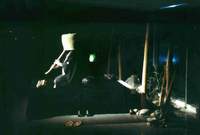
3.1. Solo performance play is primarily focused on interpretation itself, it is a form of personal spiritual practice. During lessons under the control of a master, during practice it is, above all, mental and breathing exercise (the person-self relationship), during actual play ("performances") the compositions are meditation. The mind concentrates - is moulded - the concurrent realisation and, at the same time, the reverse operation of honkyoku compositions - specifically structured breathing /! - suidan/ and sound clusters interacting with mental processes - (meditation = personal relationship: person - God, the person "listens" - God "speaks").
3.2. Collective play during services – this is collective (spiritual) meditation practice within the framework of liturgical rites. It represents an enhancement of the mentioned process of meditation by the "combining" of the mental-energetic potential of the participating individuals with the aim of communication with the universe (collective relationship: a group of people - God)./6/
3.3. Playing as interpersonal communication
(relationship: person - people)
- instead of verbal expression during interaction with surroundings, during
takuhatsu - religious
mendicancy (it is said that the
traditional thanksgiving by means of the Hachi Gaeshi – Returning of the
bowl - was never amiss), at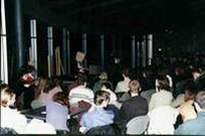
3.4. Playing of the shakuhachi as a supplementary recreational activity ,the special gikyoku repertoire was played – compositions for rest and gladness. Needless to say komusˇ were only allowed to play such in the afternoon.
4. The Musical Language of the Shakuhachi Honkyoku
Solo one-voice performance of
the woodwind instrument supposed a dominance of melodic components of the
musical language.
4.1.
A speciality of the
traditional repertoire is the significant sonic character (the ideal for
the sound is the “murmuring of the wind blowing through the bamboo grove”!). The
most important carrier of the musical structure is firstly
timbre
with "noise
sounds" (ikiatari, atari etc.). Such noise sounds and
transformation of timbre (by change of dynamics, by means of various
types of vibrato, such as furi, or yuri, complex sonic ornamental
formulae like hororo, korokoro etc.), which in combination with the
kinetic component constantly oscillating around the limits of motional
stagnation, are shifting the melodics to, at least, the
second level of
importance.
4.2.
Also of note is the
systematic work with microtones and intonation
(meru, karu, merikomi, nayashi, special
suri glissando etc.) from the standard tonal terrain, realised by
the changing of the
blowing angle in combination with partial covering of the
fingerholes.
4.3.
Especially remarkable and
characteristic are the mentioned timbre elements, such as aspiration,
overblow and so on, denoted as iki atari – "breath accents".
.
A speciality is also
tone setting, which, different from our usual articulation with the help of
the tongue, is managed through finger articulation by stroking the finger
on the tone hole
which is used exclusively - atari (tone
setting), often in combination with breath articulation - iki atari.
4.5.
From our point of view the
shakuhachi tonal terrain itself is very unusual. The basic
framework of the anhemitonic pentatonic
d1 f1 g1 a1 c2 d2,
which the instrument gives in the lower octave via the successive covering of
the 5
finger holes,
always expanded
in honkyoku by a range of further tones. E.g. between
a
and g,
there is a Chimeru
position which gives the
a
tone, as a rule, ca ¼ of a
tone lower, and U position which gives the
a
flat
ca ¼ of tone lower. Similarly between
f
and d
there can be a spectrum of tones from
f
through lower
e
flat
etc.
5. Specifics of the Musical Language of Fuke Honkyoku:
5.1. Tectonics
Each composition forms one, or
several (max. 5) large parts of a time period of 3 to ca 17 minutes. They
are usually made up of a number of "themes“, which are composed from
various structured phrasal chains. The phrases, each
lasting a full breath(!), on the level of our small musical sentences, or
their parts (half-sentences), are made up of standardised timbre-melodic
elements and formulae, thus not simply tones at all! These precisely
formalised and fixed sonic-melodic elements and formulae are actually the
building "blocks" of honkyoku compositions.
5.2. The Kinetics of Honkyoku
Kinetics are the determined interaction, or the "contention" of transcendental and musical time.Transcendental Time – a term indicating striking temporal disproportion in musical phenomena, as a rule liturgical, where motion and temporal proportion do not occur as a result of musical regularity laws and logic, but to a much greater extent as the result of the bonds with the divine and "eternity". Motion in honkyoku is significantly static, precisely because of the dominance of the sacred purpose and function, and to a certain extent, it is also subject to breathing meditation, the principle of the suidan - the phrase of one full breath - thus a form of breathing exercise.
Transcendental time is evident, above all, in honkyoku compositions with a primarily meditative function (e.g. "The Three Classic Pieces" of Kyorei – The Empty Bell, Mukaiji – The Flute above the Misty Sea, Kok˙ – Empty Sky, or Reibo – Yearning for the Bell etc.)
Musically structured time is, of course, asserted in honkyoku, as the compositions evidently have a musical aspect as well. It is prominent not only in the parts of the gikyoku repertoire ("entertaining and recreational" music for the relaxation of monks, e.g. Darani) and non-verbal communicative, meant particularly for pursuit outside the monastery (Hachi gaeshi – Returning of the Bowl, Monbiraki – Opening the Gate etc.), but by means of obvious musical effects and to a certain extent even in the primarily meditative repertoire./7/
5.3. Rhythm
In honkyoku free rhythm is predominant. Motion is determined by the principle of suidan (sui – breath, dan - part, degree, section etc.) - the phrase lasting a "full breath". The length of the phrase is understandably different for each different player, according to individual breathing disposition - thus there is an evident correlation with original breathing exercises during meditation.Many indicate a traditional notation – actually a form of tabulature, where individual characters of the katakana alphabet are read in columns from top to bottom and right to left. The characters indicate specific fingerings on the instrument and the notation distinguishes three various time values./8/
5.4. Time Values:
Each katakana character indicates a construction element or formula having one of the following three time values:a/ Short – if the next character is written immediately after the preceding.
b/ Long – if there is a vertical line after the character.
c/ Very Short – if a smaller character is written before the standard one, it means roughly the equivalent of our melodic ornament, a grace note.
Rests also have 3 various basic values:
a/ Phrase end - horizontal line, measuring one full breath according to the suidan principle, is in essence a short pause for breathing.
b/ More distinct pause - a small circle, indicating a larger caesura, or longer rest than is necessary for breathing.
c/ Section end (e.g. 1st part of the Kyorei, 5 parts of the Kok˙ etc.), or composition end - two adjacent horizontal lines.
In practice the phrases are often not played in any way according to the notation and principles of suidan, but in defined time-supported rhythms. It is essential to listen to the teacher and memorise./9/
Honkyoku notation probably appeared at the end of the 18th century, and is said to have originally served as a "testimonial", the master wrote in calligraphy and confirmed it with his stamp, as a certification of the hand-over and acceptance of the composition after recognising that the student has mastered it.
Today the notation is above all a mnemonic aid, fixing the order of fingering, and the rising or falling of the tone. It does not determine the extent to which, in principle, it is necessary to listen and memorise, above all, the detailed (often micro-interval) intonation flexion, intonation oscillations (furi), timbre elements, special "techniques", often of a sonic character (atari, iki atari, muraiki, vibrato yuri, yuri komi etc.)
These days it is starting to be often even used for playing "from a score"(!) on the podium, which is perhaps logical for the Tozan school and does not encroach, but, for the 36 honkyoku compositions of the Kinko school and particularly in the case of the Myˇan school it is not appropriate and it manifestly collides with the honkyoku Zen essence.
6. Tectonic Structure in the Honkyoku
6.1. Tectonic Structures on the 1st Hierarchic Level:
Elements and Formulae.
6.1.1. Elements - tones produced by the flute, basic tonal range and fingering - Ro(d1), Tsu(f1), Re(g1), Chi(a1), Ri(c2), U(a flat), I(d2), A(c2), sannoU(b flat2), nishigonoHa(c2) etc., equivalent to speech sounds in speech.
Even the elements themselves can come into play during the construction of phrases, though quite exceptionally (e.g. the 1st phrase in the Kyorei etc.)
6.1.2. Formulae - these always have two components:
a/ intonation – each has a
concrete tonal pitch, which can change in time due to various types of
inflection (intonation oscillations - furi, temporary lowering of ca
¼ of tone - merikomi etc.) - equivalent to vowels (a,e,i,o,u) in
speech.
b/ sonic – various "sounds" as
iki atari breath accent, overblow, finger articulation by stroking of the
finger over the tone hole - atari etc. - equivalent to consonants.
Both of the
components together form the characteristic
compounded construction elements:
6.1.0. Archetype - elements and the simplest, embryonic forms of some formulae, occurring particularly in Kyorei composition.
6.1.2.1. Simple Formula - from two or three elements with pertinent sonic components, such as HaRo, TsuRe, TsuTsuRe, HaI, ChiU, HiU etc., equivalent to syllables in speech.
6.1.2.2. Structured Formula - composed from more elements and sonic components concretely organised, e.g. Reon - progressively with quickening alternation of two tones, HoRoRo, HaRaRo, closing formulae daimeruRoRofuriRofuri – analogous to the "Amen" formulae in Gregorian chants etc., equivalent to words with a meaning beyond that of standard sentences, e.g. "Raining!", "End!", "Let's go!", "Enough!“ etc.
6.1.2.3. Rhythmic Formula
- with concrete rhythmic development (occurring only rarely), e.g. KoRoKoRo etc.
6.2.1.
Phrase (segment) - sections lasting one breath (according to the
principle of suidan, phrase of one full breath), composed of elements
and formulae. Each phrase can have one or more elements or formulae,
depending on whether they can be played in one breath(!), in Kok˙, for
example, one phrase is made up of 19(!) tones, whilst the beginning of
Kyorei is a pure Tsu element-

6.2. Tectonic Structures on the 2nd Hierarchic Level:
Phrase
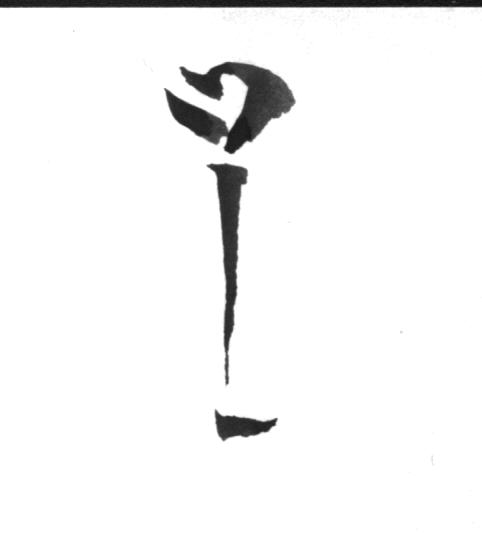 archetype – one long straight
f1 tone.
A phrase is roughly equivalent to a short musical sentence, sometimes it is only
a part-component ("half sentence") of a higher component to the extent of a
short musical sentence.
archetype – one long straight
f1 tone.
A phrase is roughly equivalent to a short musical sentence, sometimes it is only
a part-component ("half sentence") of a higher component to the extent of a
short musical sentence.
6.3. Tectonic Structures on the 3rd Hierarchic Level:
"Theme"
6.3.1."Theme" – usually formed by a chain of at least two phrases. Introductory "theme" of the composition Taki Ochi – The Falling Waterfall has six phrases, for example.
6.3.2. Characteristic Theme - typical for a given specific composition, usually used more times as it is usually with the theme in European music (e.g. the well-known "Kok˙ theme" - three times phrase formed of TsuRe etc.) - equivalent of compounded musical sentences, e.g. one part of a ternary or little rondo form etc.
6.4 Tectonic Structure on the 4th Hierarchic Level:
Composition, Parts of Composition
6.4.1 Composition - is formed from a number of such "themes" of the 3rd hierarchic level, often very complexly mutually interconnected - by the exercise of known musical compositional processes, such as repetition, variation, "thematic and motivic work", reprise, reminiscence, generic affinity etc. Shorter compositions are structured in this way, e.g. Chˇshi, Hifumichˇ etc., which correspond to our categories of large forms and can be arranged for example like binary form, rondo etc.
6.4.2 Parts – such a developed and arranged whole is still not necessarily a whole composition, but one of a number of parts, which are always connected attacca, e.g. five in Kok˙, three in Taki Ochi, two in Kyorei etc. In that case it could last more than 20 minutes and corresponds to our cyclic forms but in one movement and without any structural contrast.
7. Kyorei – The Empty Bell
The Kyorei composition, referred to as Kyˇtaku, is really unique in the context of honkyoku. Only a few basic compositional elements are used in it from the many used in honkyoku, and all are here always in quite disengaged, almost archetypal-embryonic form. It is possible to well imagine that just this is the kind of original model and inspiration of all the other fuke honkyoku compositions and the Kyorei, especially, is a sort of an authentic embodiment of the essence of "blowing" Zen.
Therefore I append here as model examples of treatments of specific musical speech analysis of these special compositions:
- Appendix 1: Faksimile of the Original Kyorei Notation (of Jin Nyˇdo)
- Appendix 2: Projection of Melody
- Appendix 3: Table of the Tonal Material of the Principal Myˇan honkjoku Pieces
- Appendix 4: Table of the Tectonic Structures of the Kyorei
 |
 |
 |
 |
| Appendix 1 | Appendix 2 | Appendix 3 | Appendix 4 |
Schemata of Kyorei Tectonic Structures
Recording: Mitsuhashi Kifu, 6:38 (Notation Jin Nyodo)
1. Elements and Formulae Used in the Kyorei (Hierarchic Level 1)Tsu(1), TsuRe(2), U(3)merikomi,
sanno
URi(4), RiI(5),meri
TsuRo(6), daimeriRo(7)
2. Phrase – always played on one full breath (Level 2)
such as appended phrase no. 5:
RiI-I-I-Ri-Ri-I-/
3. Themes in the Kyorei (Level 3), tectonic algorithm of the composition:
a - "Cephalic Theme" - 1/2/3/4(2+)/
Transformation of the “Cephalic Theme“ and:
a1: 1/2/3/4/ a2: 1/23/4/ a3: 123/4/
a1
`: 1/2/3/2+/ a2`: 1/23/2+/ a3`: 123/2+/
Mathematical Algorithm of Work with the "Cephalic Theme“ and:
a1,a2,a3...,a2...,a1`, a2`,a3`..., a2, a1/: (1th part of the composition) phrase 1/2/3/ 1/23/ 123/ .../1/23/... /1/2/3/ 1/23/ 123/... /1/23/ - and transformation of numbers: a2,a3...,a2,a3...,a2..../: (2nd part of composition) /1/23/ 123/... /1/23/ 123/... /1/23//
b – 2nd theme: 4+/5/
c – 3rd theme: 6/6/6/7/7-/
4. Parts of the Composition (Level 4)
2 parts AA┤
5. Formal Scheme of the Kyorei (Hierarchic Level 5):
Kyorei Composition, as well as part of the group of compositions called "Three Classical Pieces" Sankyorei
A
a1 a2 a3 b1 a2 b1
otsu 1/2/3/4/ 1/23/4/ 123/4/ 4+/5-/ 1/23/4/ 4+/5/
a1┤ a2┤ a3┤ c1 a2
1/2/3/2+/ 1/23/2+/ 123/2+/ 6/6/6/7/7-/ 1/23/4┤//
A┤
a3 b2 a2┤ a3┤ c2 a2┤
123/4┤/ 4+┤/5┤/ kan 1/23┤/2+/ 123┤/2+/ 6/6/6/7/7-/ otsu 1/23/4`//
Conclusion
The musical language of the shakuhachi honkyoku very closely corresponds to the primarily sacred - meditation focus of this tradition. Motion is completely subordinated to the principle of controlled breathing, and is always bordering on motion stagnation. Static motion and the sacred context inhibit the possible formative function of melodic components, and it is really timbre that functions as the holder of important connections. The analysis and subsequent systematisation of the elements of the musical language of fukezen shakuhachi honkyoku has also, I hope, shown that such compositions can function not only as means to very effective meditation practice, but also can simultaneously operate as highly refined and sophisticated musical artefacts, whose principles are surprisingly close to our own musical thinking.
Notes: Bibliography:BLASDEL, Christopher Yohmei: The Shakuhachi, Notomosha Corp., Tokyo 1988
GUTZWILLER Andreas B.: Shakuhachi: Aspects of History, Practice and Teachings, Wesleyan University Ph.D., USA 1974
HARICH-SCHNEIDER Eta: A History of Japanese Music, Oxford University Press, London 1973
HISAO Tanabe: Japanese Music, Kokusai Bunka Shinkokai, Tokyo 1936
KISHIBE Shigeo: The Traditional Music of Japan, ONGAKU NO TOMO SHA EDITION, Tokyo 1984
LEE, Riley Kelly: Yearning for the Bell: A Study of Transmission in the Shakuhachi Honkyoku Tradition, Dr. thesis manuscript, University of Sydney, dept. of Music, 1992
Shakuhachi - The Encyclopaedia of Musical Instrument (I. Kitahara, A. Matsuda, M. Matsumoto), Tokyo Ongaku Sha CO., Tokyo 1990
TUKITANI
Tuneko, SEYAMA Tˇru and SIMURA Satosi (trnsl. by Riley Kelly Lee),
The Shakuhachi: The Instrument and its Music, Change and Diversification,
Contemporary Music Review, 1994, Vol 8, Part 2, pp. 103-129 (Harwood Academic
Publishers GmbH)
CD Kifu Mitsuhashi - The Art of the Shakuhachi vol.2, Celestial Harmonies 13225-2, USA 2003
CD Vlastislav Matou╣ek: Calligraphy, Angel AN 99-006, Prague 1999
CD Vlastislav Matou╣ek: Taki Ochi, ARTA F1 0119, Prague 2003
CD Vlastislav Matou╣ek: Calligraphy II, Nextera, KMa s.r.o. LK 0146-2, Prague 2004
CD Watazumido: Hotchiku, Universal Music K.K., Polydor, UDC-499, Japan 2000
CD3 Yoshimura Sˇshin: The Anthology of Myoanji transmitted Shakuhachi Honkyoku, KM-199501, Japan 1995
CD6 Recordings of Jin Nyodo, Teichiku Records Co. XL-70134-6, XL-70137-9, Japan 1998
LP The Mysterious Sounds of the Japanese
Bamboo Flute. Watazumi-do, EVEREST 3289, S-4374, California
MC I - III, Tanikita Muchiku: Shakuhachi honkyoku of Myoan-ji XXXVII, HT-01, HT-02, HT-03, Japan
